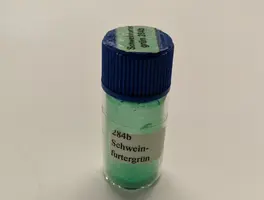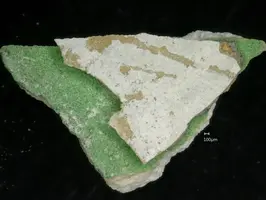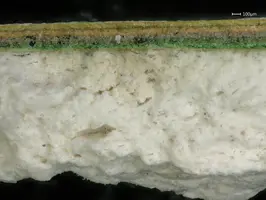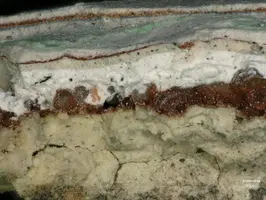Environmental, monument and safety-conscious handling of Schweinfurt's greenery
Model Innovative Measures for Conflict Resolution at the Intersection of Historic Preservation and Environmental Protection
Content and aims
The so-called Schweinfurt Green (SG) is an artificially produced green pigment, a copper arsenite acetate Cu(CH3COO)2 · 3 Cu(AsO2)2. Schweinfurt Green and similar pigments were valued for their color brilliance, especially in Classicism and Biedermeier, and were frequently used in living rooms, wooden fixtures and cabinets for setting. Its use as a coating on wallpaper and plaster surfaces is particularly well documented. However, it is precisely these surfaces that cause acute problems in upcoming renovation work due to their hazard potential. Health-damaging effects of the arsenic-containing paints were assumed as early as around 1830, but it took another 150 years before the production of Schweinfurt Green was finally banned.
According to modern understanding, Schweinfurter Green is to be regarded as a hazardous substance. However, it is often found in historic paints and is often hidden by paint coatings applied later. In the course of measures, construction workers and restorers in particular come into contact with the toxic materials, and work and living spaces are also affected.
The aim of the project is therefore to develop model, innovative measures for conflict resolution at the interface between monument protection and environmental protection. The requirements of modern environmental and health protection with regard to heavy metal contamination, such as arsenic, are initially in clear contrast to the demands of monument protection, from which the greatest possible preservation of original historical substance is derived.
Methodology
In the project, new methods are developed and model procedures are applied that contribute to the protection of people and nationally valuable cultural assets in the case of a Schweinfurt Green finding. Currently, the diagnosis of findings on Schweinfurt green in paints, wallpapers or wooden objects often involves the complete removal of the stocks, irrespective of any heritage value. A central task of the project will therefore also be to test methods for masking SG using different procedures and to evaluate their practicality. The project concerns both questions of occupational health and safety for employees who come into contact with SG in the course of their work and the consideration of monument conservation concerns and objectives.
The apparent versatility in the analytical method spectrum (e.g. REM-EDX, REM-RFA und FT-IR-Spektroskopie) results necessarily from the versatility of the sample types of the contaminated material. Further investigations on pure substances and on the immersion objects will be carried out in order to derive suitable methods for on-site investigations as well as for laboratory investigations on extracted samples.
In addition, mobile measurement systems will be tested on a selection of objects suitable for on-site analysis (e.g. handheld XRF devices, mobile spectroscopy (NIR), indoor air or gas measurements and particle measurements or wipe samples of dust, as well as person-borne/person-related measurements). On-site analytical investigations and measurements will include a second focus on the examination of existing and, where possible, newly created restorative masking of SG settings.
The results of the analyses will be evaluated with regard to the hazard and action guidelines for various activities involving arsenic-contaminated art and cultural property will be derived from them. Also assuming that the entire spectrum of methods will not be available in all cases that arise in the future, it must also be possible to evaluate the results from the limited spectrum.
Guide to action
As part of the research project, an action guide for dealing with historical green frames in the case of suspected Schweinfurt green has been created, which is now available on the website of the Institut für Diagnostik und Konservierung an Denkmalen in Sachsen und Sachsen-Anhalt e.V.: Link to the action guide (in German language)
Project team
Applicant and Grantee:
- Institut für Diagnostik und Konservierung an Denkmalen in Sachsen und Sachsen-Anhalt e. V. (IDK)
Project partners:
- Zentrale Analytische Labor (ZAL) der Brandenburgischen Technischen Universität Cottbus-Senftenberg (BTU)
- Bauforschung - Denkmalpflege, Dr. phil. Insa Christiane Hennen (ICH)
- Centre for Heritage Conservation Studies and Technologies (KDWT), University of Bamberg, Professorship in Materials and Preservation Science
- Institut für Arbeitsschutz der Deutschen Gesetzlichen Unfallversicherung (IFA) (assoziierter Partner)
Funding
The project is funded by The German Federal Environmental Foundation (Deutsche Bundesstiftung Umwelt DBU) it is listed under the file number 35408.
Pictures
Click on the images to enlarge.




